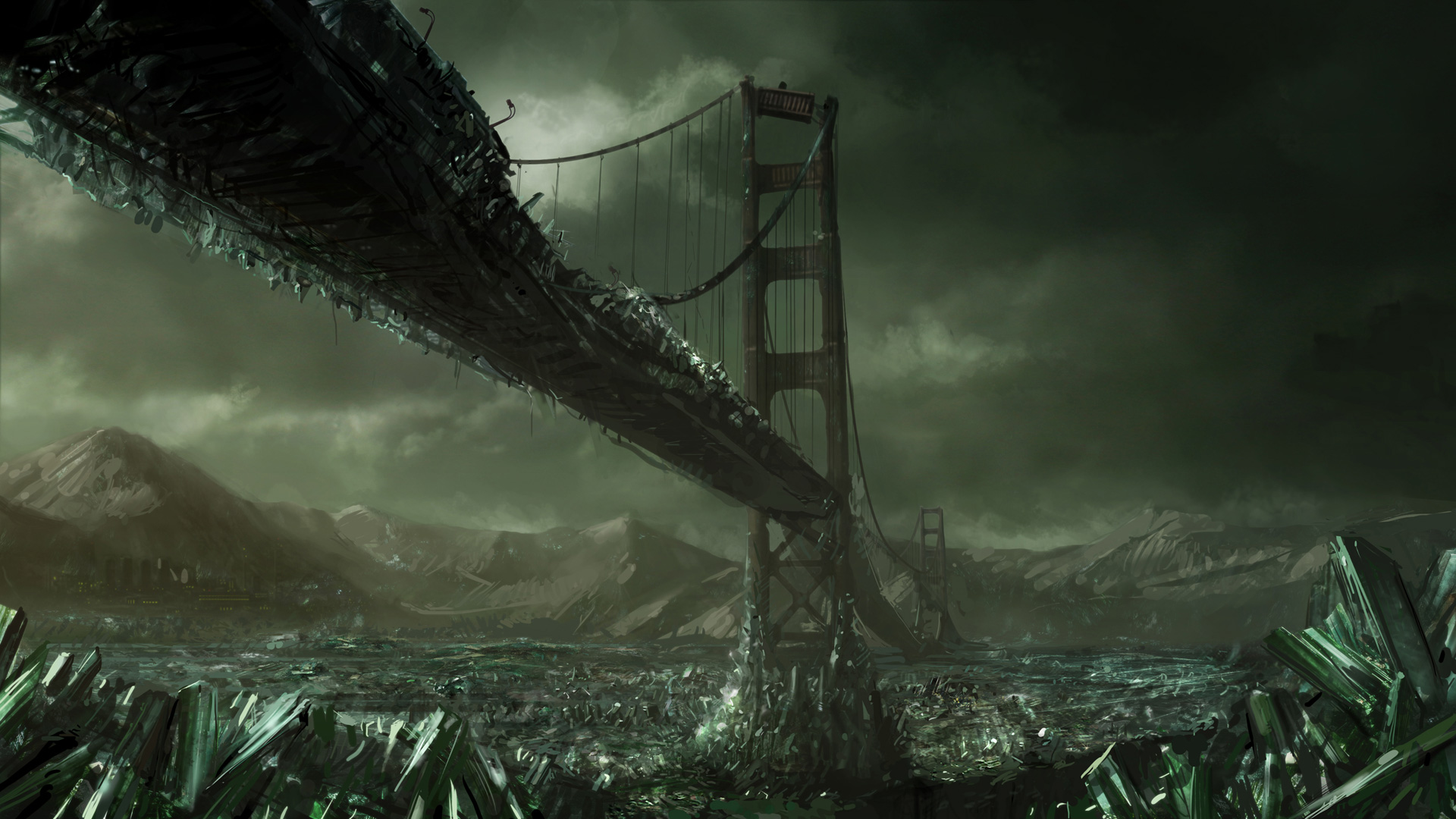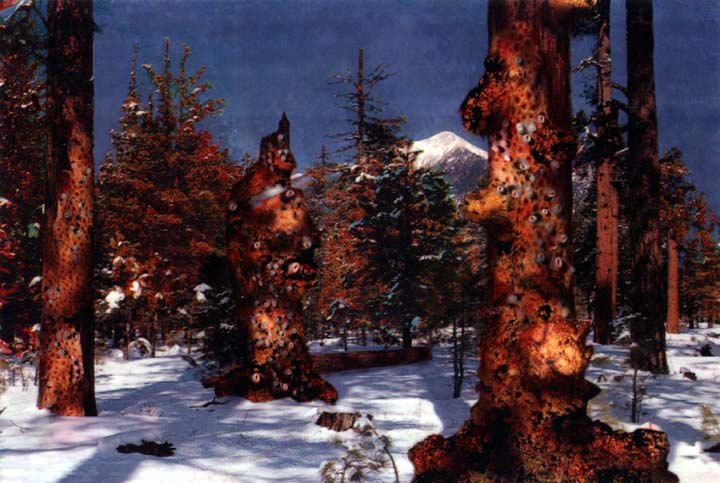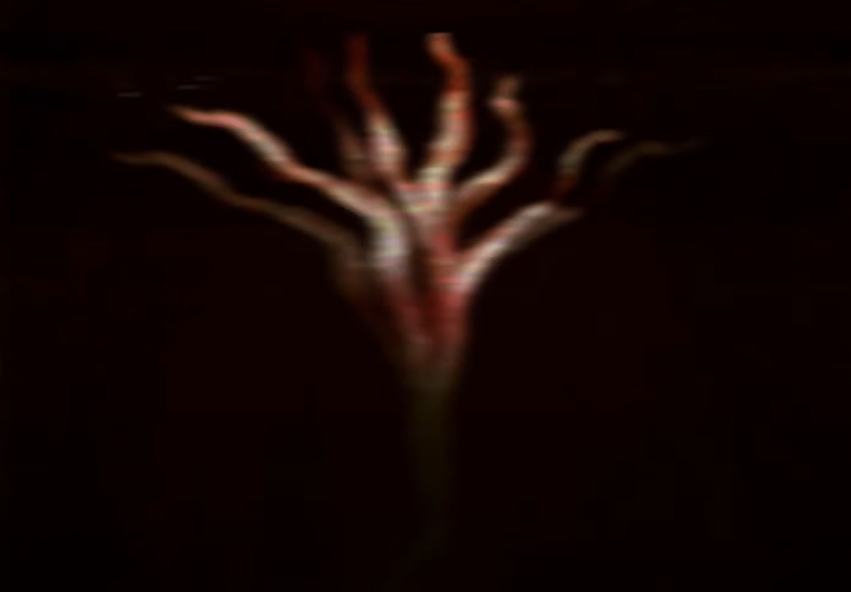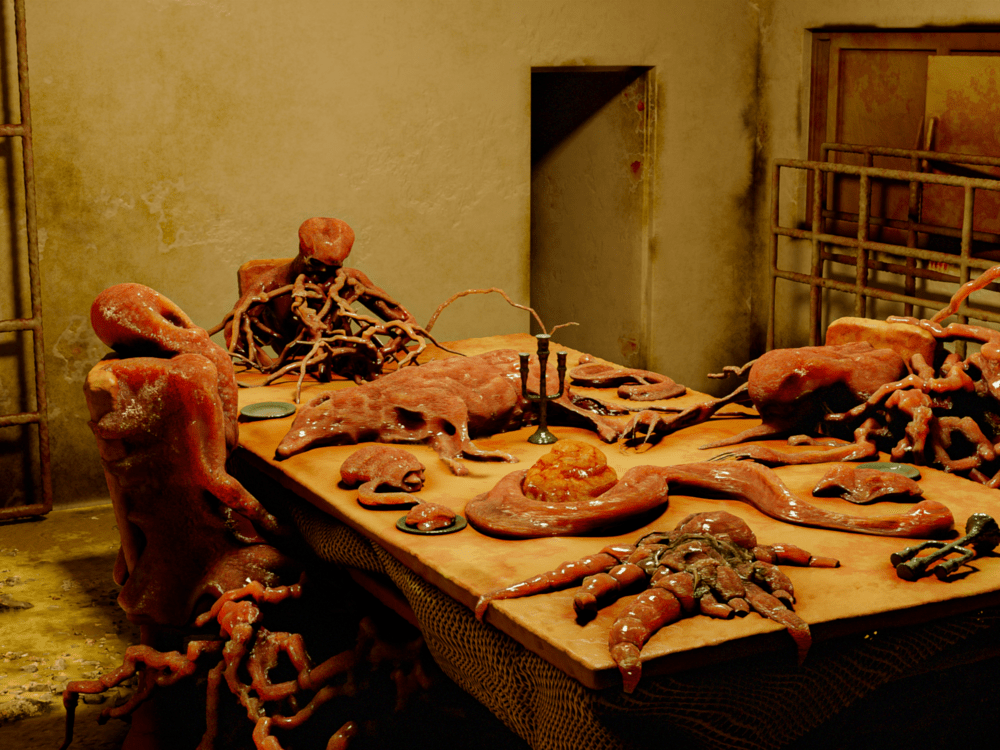The phrase “Sarkic” is a Greek word, meaning flesh. It’s a phrase used by the Gnostics to refer to carnal urges: those urges that are instinctual, animalistic, and fleshy. The term now, from my knowledge, is mostly known due to it being assocaited with a flesh-worshiping cult in the SCP collaborative-writing project, at least, that’s how I first came into contact with the term.
The Sarkic Cult within the collaborative writing project fits a mold: It’s a cult that practices eldrich magic with a twist of being in favor of all things fleshy, warm, and festering. It loves disease, is generally luddic in nature, and in worship of some type of Lovecraftian “Old God”. You can get the picture from here, and likely can draw upon some other media as a parallel. Flesh cults are a common and boring trope at this point, the interest in them almost always comes from execution and allegory rather than the concept in itself.
However, this is not a review of the SCP Foundation’s Sarkic Cult, or the occult in general (as I find that to be a massive bore). Instead, it’s the interest in the “Sarkic” (or flesh) part of Sarkic cult. The concept of vile flesh is common, but manifests itself in a variety of ways. I wish to dissect this concept and see what about it is so alluring.
The particularities of how I will do so will be by looking at different manifestations of the vile, carnal, and fleshy trope and dissecting the commonalities between them. Of course, this will by no means be a scientific sample size, but rather a modest collection of ones that come to mind.
Gemini Home Entertainment’s Deep Root Disease
To discuss the actual vile flesh, you must know what it is. Thankfully, we live in a time of short, easy to consume media: So just have a gander at the video explaining it from the source itself.
After watching the video, there are a couple of things about this specific manifestation of the Sarkic are apparent:
- The disease takes terminology from plants (roots, bulbs, sprouts).
- The disease mimics behavior of plants (germinating, rooting, then sprouting)
- The disease is a disease, it’s a classical hazard to human life
- The disease metastasises quickly
- The disease causes tumors, and then body horror
- The disease has effects on mental well-being (failing questions about memory are signs of infection).
Without any other subjects to comapre this manifestation to, this is all just interesting facts. Keep these in mind as we look at other instances of the Sarkic trope.
Command & Conquer’s Tiberium

Background Context, yet again, can be found in a short-form video. A full set of information on the substance can be found in this long-form video.
Tiberium itself is not Sarkic in nature. It’s a colored crystal with radioactive and toxic properties. Instead, the Sarkic behavior of Tiberium comes out in its seeding and distribution system. It uses fleshy trees that protrude from the ground to send spores, and it creates plant-like roots for resource extraction from the Earth. When brought into contact with conventional cellular life, Tiberium can infect it, and if in enough quantities, can create viceroids.
The life around Tiberium is Sarkic. It feeds and spreads similar to fungi, and if introduced to life, acts like a disease. It can create body-horror mutations in victims of its poison. Tiberium itself spreads across the planet quickly.

I don’t believe it’s a stretch to say that Deep Root Disease and Tiberium, while very different, hold certain similarities:
- Both operate in a plant or fungi-like fashion
- Both mutate living organisms into excessive masses that serve the infection
- Both can be categorized as a disease (Tiberium in certain contexts)
- Both cause growths in the infected, and with Tiberium, growths on the Earth itself.
More entries are needed to start seeing a pattern. For that, we can return to the SCP Universe to look at SCP-610: The Flesh that Hates.
SCP 610
The original article itself is rather short, so linking it without summary will be fine. Here is the original and a high quality reading. Reading/listening to the “Field Logs” is not necessary, but highly encouraged.
Yet again, we see some common threads between this and other discussed Sarkic pieces of literature:
- Plant-like behavior (Under unknown conditions an infected individual will cease moving and place itself in a location it deems suitable where it roots itself)
- Mutates living organisms into excessive masses that serve the infection
- Is a disease
- Causes growths
- Terraforms the area to its needs (akin to Tiberium)
The Pattern broken down
I’m sure that I could list more instances of vile flesh like the ones I have already listed and we could find more commonalities. However, what we have now already paints a general picture of what’s going on, one that can be analyized and broken down so that, if someone wishes to write about vile flesh, they understand the basics of what makes vile flesh so scary.
The common traits that I see are as follows:
- Vile flesh is a scourge on whatever it touches, rather it’s soil or life, and attempts to assimilate it into the mass.
- Vile flesh has tendrils for parasitizing resources from a host, often in a plant-like fashion.
- Vile flesh crafts and molds its hosts into beings that benefit the vile flesh.
- Vile flesh spreads, the quicker the spread, the scarier.
Each of these traits are very familiar to humanity on a historical scale. They’re the traits of disease and parasites, most specifically of our set, fungal infections. From a historical point of view, it makes sense why we fear the nasty and diseased things, as that’s a sign of being infectious, which could kill us and our family.
However, that alone is not the whole picture. If it was, then Sarkic and vile flesh would include mass pandemic by more mundane sources. Massive flu outbreaks are very deadly, can contort the body, and spread quickly. They’d fit the definition, but aren’t on the same level of scary. Is it just the intensity, or are we missing something?
I’ll cut to the chase and just say it: Vile flesh is not scary because it’s infectious, but instead, because it’s disorderly. A victim of the Flu is still a human, one of us, just with a microscopic parasite harming him. Vile flesh on the other hand converts a human into something inhumane, turning what once was an ally into an enemy.
More mild and historical examples of vile flesh can be seen in The Bubonic plague and Leprosy. Both are body horror diseases that contort the body if left untreated. The Bubonic plague in particular is very likely the cause of the black death, which anhilated the population of Europe during the 1300s. While neither of these are as extreme as their fictional counterparts, they are contortions of the human form that lead to discrimination against the victims, in a cross-cultural fashion. Everywhere from the United States to Japan participated in this forced isolation for one reason or another.
Sarkic tropes pull on the natural fear humans have of the disfigured, the diseased, and the spread of said disfiguring disease. Most of the diseases that are like this in reality are awful, but treatable these days. Medicine gives us the power to kill many of the horrors we have actually dealt with.
However, given that human fiction tends towards the extremeness of our fears, we can look at fiction, which isn’t bound by reality, to see what traits would amplify disease to a state of true horror. Those traits seem to largely be the aspects of dehumanization, spread, and incuribility.
If a vile flesh disease isn’t dehumanizing or converting humans to its side in some way, then it’s just not Sarkic in nature (unless you cound the Flu as vile flesh). If a vile flesh disease is incapable of easy spreading, that is, it’s hard to become infected, then the disease is not conventionally dangerous and can be contained and studied. If the vile flesh is curable, then the disease, no matter how far it gets, can be reduced in danger by catching it early.
The biggest defining factor is the dehumanization. Rather that means the vile flesh consumes and incorporates its victim (keeping them alive in the process), it pupiteers it to spread the vile flesh, or otherwise abuses another lifeform for its own benefit in the pursuit of unconstrained growth.
Lesser aspects of the Sarkic trope
While all that has been discussed so far is core to the Sarkic trope, there are many addictional, modifying factors that enhance the trope’s ability to strike fear or intrigue into the reader. The control over these lesser factors are often what creates differentiation between types of vile flesh, and lead to interesting flavors and experimentation when it comes to the literary trope.
Carnalism
As creatures devolve through when coming into contact with an instance of the Sarkic trope, it often turns an otherwise reasonable human being into a carnal, instinctual, and animalistic creature. Look no further than modern concept of the infected Zombie. While far from as scary (likely due to oversaturation) than some of these other infections, zombification would fall under the category of Vile Flesh (but perhaps as its own subgenre)
For examples as listed, the Tiberium creatures, primarily the Visceroid, is a highly aggressive creature, incapable of reason. Similarly, SCP-610 instances “actively and aggressively attempt to infect anyone approaching them” as well. Carnalism is common and seems to augment the dehumanization aspects of Sarkic tropes.
Unconstrained Growth
Tiberium, SCP-610, and Deep Root Disease grow in unconstrained forms and fashions. Tiberium spreads quickly and aggressively wherever it can (in lore, it eventually mutates into self replication rather than using a spore system). SCP-610, if it’s not contained, rapidly infects and spreads anywhere it can. Flesh creatures that “root” themselves in the ground take control of an area by spreading their flesh around. The effects of Deep Root Disease can be witnessed here.
All three create areas of denial, and spread as much as they can to do so. They terraform their areas for their own replication, usually making them ecosystem destroying. This destruction makes it easier to spread in a function that’s exponential in nature. This aggressive area denial and rapid acceleration augments the spreading aspects of the disease mainly, but also, given that they are ecosystem disrupting, are dehumanizing due to their disorderly and destructive nature.
Antithesis: War with machines
Unsurprisingly, the war between biology and machines even extends to the realm of Sarkic tropes as well. Advanced Technology is used to fight Tiberium and SCP-610 is combatted with flamethrowers (humanity’s ever-classic tool augmented heavily by technology for more efficient use). Almost never in stories with Sarkic tropes does biology simply triumph over biology, instead it has to be the systematic, rational, and cold constructs of logic and steel that destroy the vile flesh. Often, if biology alone could triumph, humanity would simply persist by the nature of being biological creatures (which happens in the real world, but isn’t an interesting story to write about).
Advise for using sarkric tropes in media
Sarkic tropes are often underused in their pure form, but rather used as an excuse to do body horror or make something edgy. This unfortunately has lead to a drought of good content that focuses on Sarkic tropes as a whole. So, to better aid in the creation of these stories, I have devised a list of tips and interesting points to consider when writing such a story.
Questions asked by vile flesh
For art to be good, it should reflect society and the human condition. The easiest way of doing that is to propose questions through the use of tropes like the Sarkic tropes. Using the extreme nature of vile flesh, you can fictionally change society to bring up unconsidered ethical, moral, political, or philosophical questions, ideally in a way that’s tactful. I’ll be skipping out on some of the more obvious ones like “what to do during disaster”.
What is good flesh?
Personally, this is the reason I wrote this article: I wish to see a work with Sarkic tropes ask the question of what is good flesh and what is bad flesh.
However, what that means is rather vague, so we’ll need an allegory: We can easily pinpoint what is a good machine and a bad machine by said machine’s utility. A good machine would be like much of what we make: The computer is a good machine as it allows us to transfer information quicker (rather that information causes good or bad things is up for debate), the shovels we have are machines useful for digging up dirt, which allow us to plant crops and survive longer, and my fridge is a great machine because it’s where I store all my food that keeps me alive. All these machines have utility in some way that’s positive, and that’s good. On the other hand, bad machines are machines that harm. Aggressive artifical intelligence is an enemy of humanity and could compete with us, “grey goo” is just the mechanical version of the vile flesh trope, and survalience equipment, when used against innocent people, can subjegate the public to whoever is doing the surveilling.
This distinction gets at the core use of a machine: it’s a tool for the betterment of the flesh, mind, and spirit. When a tool is against these things, then the tool is evil or otherwise bad. When a tool is for these things, it’s good.
Vile flesh is bad flesh, it’s against flesh, mind, spirit, and body. Good flesh on the other hand is… unknown. What constitutes the utility of flesh and its purpose? If you’re a materialist, then you combine flesh, mind, and spirit together. If you’re a dualist, then the point of flesh may be to serve the spirit. Discussing the point of good flesh, which we should identify as ourselves (and perhaps others), is a big, untapped philosophical question that could get an interesting, dramatic, and worthwhile answer in the form of an art piece involving the Sarkic tropes.
Inspiration sources
Of course, always read the classics and take good ideas from good art. That’s common knowledge, but art has to reflect reality to be in any way remotely good, so what in reality can be stolen from to tell a good story about Sarkic tropes?
Modern Cancer and other Diseases
Unfortunately, some of the more horrific aspects of spreading and dehumanization exist to a lesser, but more real extent, in diseases like cancer. They aggressively spread, metastizing around the body, often forming tumors that contort the flesh of the host to its own bidding. Diseases like Leprosy and the Bubonic Plague have already been mentioned for their similarity for this too.
These horrible diseases give horrible effects, which are useful to writing horrific and interesting content. Taking note of what obscure diseases do to the human body, and possibly taking it to its extreme, would be a good way of conveying the horror that vile flesh can bring. Melding these effects together, and possibly with the behavior of already existing lifeforms, can bring about novel ways to take the Sarkic trope in a new direction. As we discover more about the world, we find more ways things can go wrong, and thus more ways to scare ourselves. It’s imperitive to use this to make high quality, poignant art that has something interesting to say.
Plants and fungi
There’s are reason that termonology from plants and fungi is used when discussing vile flesh: it’s because plants and fungi are strange and disgusting when you think about them. They root into the ground, extract resources, and reproduce rapidly. We only aren’t disgusted by them because we farm them for food, are familiar with them, and they are smooth and green rather than red and fleshy. Because of this, taking aspects of mundane plants and making human-hostile varieties is an excellent way to make vile flesh. Personally, I believe tubers aren’t used enough in the Sarkic trope.

